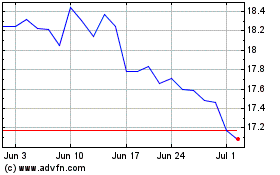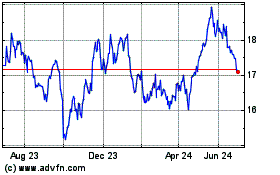Investors Back PG&E on Bankruptcy Control -- WSJ
May 22 2019 - 3:02AM
Dow Jones News
By Peg Brickley
This article is being republished as part of our daily
reproduction of WSJ.com articles that also appeared in the U.S.
print edition of The Wall Street Journal (May 22, 2019).
Shareholders that own more than 27% of PG&E Corp.'s stock
and billions of dollars worth of its debt clashed with victims of
the wildfires that sent California's largest utility into
bankruptcy.
The issue is whether PG&E deserves to stay in charge of its
multibillion-dollar chapter 11 case without worrying about rival
restructuring proposals. Shareholders, including a trio that shook
up the company's top management and board recently, said PG&E
deserves more time to figure out how to pay damage claims from
years of blazes linked to the utility's equipment.
But lawyers for wildfire claimants, in a filing last week in the
U.S. Bankruptcy Court in San Francisco, called for limits on
PG&E's ability to determine its future, given a history of
safety lapses. California Gov. Gavin Newsom last week sided with
the fire victims in a filing that criticized PG&E's leadership
and recent changes to its board, and that said the company valued
financial performance over safety.
A bankruptcy judge is set to decide at a hearing Wednesday in
San Francisco whether to give PG&E exclusive control until Nov.
29, as the company has asked, or for a shorter period, as Mr.
Newsom wants.
The dispute sheds light on the developing power dynamics of
PG&E's bankruptcy case, set to play out over a period of years
in the halls of government as well as in the bankruptcy court.
Big shareholders that are part of the group defending PG&E
also own, in the aggregate, more than $2 billion in PG&E debt
-- mostly bonds, but some loans, including pieces of $5.5 billion
in bankruptcy financing.
Only five of the 22 investment funds that signed up to support
the company as shareholders own stock exclusively. All the rest own
debt instruments, and some have much more money tied up in debt
holdings than in PG&E's stock.
In court papers Friday, the group said none of the investors
that spoke up as shareholders are legally bound to look out for
anyone's interests but their own, including the interests of other
shareholders.
Abrams Capital Management LP, Knighthead Capital Management LLC
and Redwood Capital Management LLC -- three funds that worked with
PG&E to shake up its board and management -- each owns either
bonds or insurance claims stemming from wildfire damage.
They are sharing bankruptcy law firm Jones Day and financial
adviser PJT Partners with veteran distressed-debt investors like
Centerbridge Partners LP and York Capital Management. Centerbridge
and York each has more than twice as much money riding on
PG&E's debt than in the company's stock.
It is common for big investment firms to buy debt of varied
ranking within a company's capital structure in a major chapter 11
case. What isn't common is for big investment firms to risk
hundreds of millions of dollars on stock, since shareholders almost
always lose everything in bankruptcy.
PG&E's shares have traded at healthy levels during the
bankruptcy, despite the massive damage claims and turmoil in the
C-suite. That has shifted the power structure in PG&E's
bankruptcy. While creditors typically vie with shareholders, in
PG&E's case they are aligned in this legal battle against the
people who lost homes, businesses and loved ones in wildfires
linked to the company's equipment.
In court papers, the official fire victims committee said it has
doubts that PG&E is a solvent company, as its debts appear to
outweigh its assets. If that is the case, the company's shares
would be reduced in value, or even wiped out.
An investor that owns both debt and stock in PG&E's
bankruptcy has more clout than is typical, said Jonathan Lipson,
professor at Temple University's Beasley School of Law.
Theoretically, creditors' interests are at odds with the
interests of shareholders, he said. But debt investors that also
can claim credentials as significant shareholders have amplified
their power in PG&E's case.
"What may be more important to these sorts of sophisticated
stakeholders than economic positions that might appear to conflict
are the control rights," Mr. Lipson said.
Write to Peg Brickley at peg.brickley@wsj.com
(END) Dow Jones Newswires
May 22, 2019 02:47 ET (06:47 GMT)
Copyright (c) 2019 Dow Jones & Company, Inc.
PG&E (NYSE:PCG)
Historical Stock Chart
From Mar 2024 to Apr 2024

PG&E (NYSE:PCG)
Historical Stock Chart
From Apr 2023 to Apr 2024
